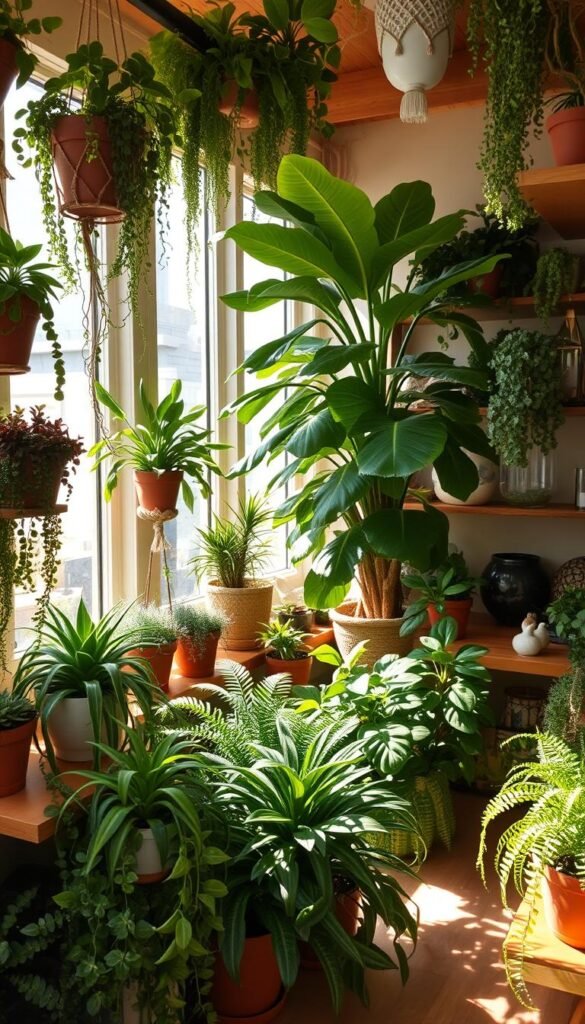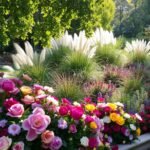Imagine walking into a room where every leaf and decor piece feels like it belongs. Styling with greenery isn’t just about adding pots to shelves—it’s about crafting a living masterpiece. This approach merges nature’s calm with your unique taste, turning ordinary spaces into breath-catching retreats.
Why has this trend exploded? Simple: people crave connection. Bringing nature indoors boosts mood, cleans the air, and adds life to rigid layouts. But the magic happens when you pair foliage with thoughtful design choices. Think textured planters that mirror your rug’s pattern or trailing vines that soften sharp corners.
Start by observing your space. Notice where light dances or shadows linger. Match plants to these conditions, then layer in decor that complements their shapes. A sleek ceramic vase might highlight a fern’s delicate fronds, while a woven basket grounds a towering fiddle-leaf fig.
The goal? A space where every element feels intentional. Mix smooth and rough textures—glossy monstera leaves against a rattan chair, or a spiky succulent beside a velvet throw pillow. Play with heights using stands or hanging planters to guide the eye upward.
Your home becomes more than just pretty—it becomes personal. With smart placement and style-savvy pairings, you’ll craft rooms that whisper serenity while shouting personality. Ready to make your walls breathe?
Introduction to Your Indoor Garden Journey
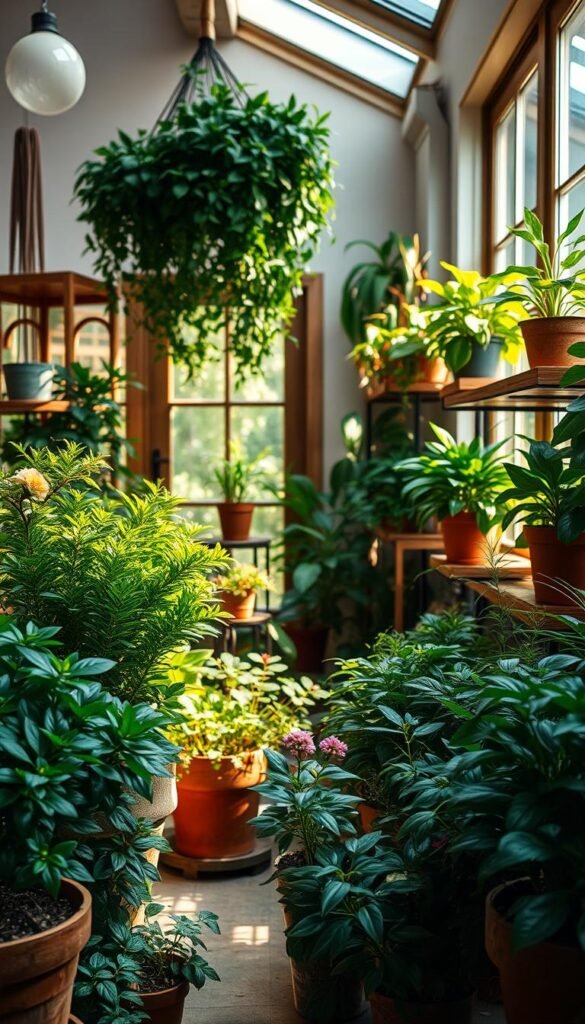
Your path to a serene living space starts with mindful plant placement. Indoor gardening merges nature’s rhythm with smart design, transforming empty corners into vibrant life sources. This practice isn’t just about growing greenery—it’s about cultivating energy flow through your home.
Think of leafy companions as living decor that does double duty. They purify air while shaping your room’s mood. Modern principles meet ancient wisdom when arranging plants using Feng Shui concepts, creating balance in high-traffic areas and quiet nooks alike.
You’ll discover how different species influence your space. A cascading pothos softens harsh lines, while a sculptural snake plant adds structure. These choices become extensions of your personality, turning generic rooms into personalized retreats.
The magic happens when form meets function. Strategically placed greenery defines zones in open layouts or highlights favorite art pieces. You’re engineering environments that support both relaxation and creativity.
This journey reshapes how you interact with your home. Natural elements become design partners, teaching you to see blank walls as opportunities for growth. Each new plant writes a love letter to your living space.
Understanding the Benefits of an Indoor Garden Aesthetic
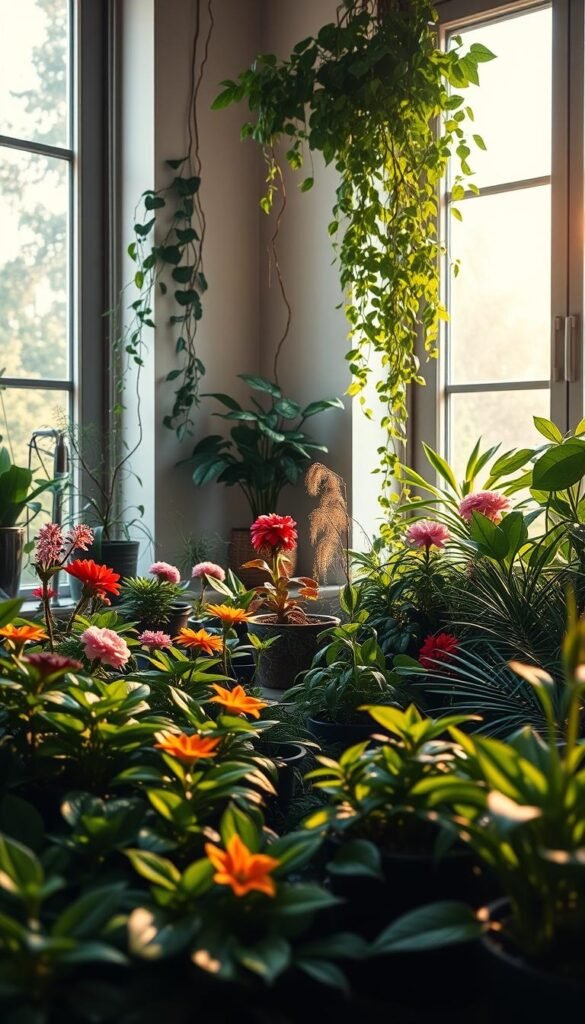
Your space becomes more than walls and furniture when greenery takes root. Living foliage acts as a silent partner—refreshing your air, calming your mind, and reshaping your relationship with home. Let’s explore how this dynamic works.
Enhancing Your Home’s Ambiance
Greenery breathes life into rigid layouts. A well-placed monstera turns blank walls into tropical escapes, while cascading ivy softens sharp edges. These natural touches add texture and movement where static decor falls flat.
Light plays differently through leaves than lampshades. Morning sun filtering through a spider plant’s fronds creates patterns no artwork can match. Pair plants with warm wood tones or sleek metals to amplify their visual impact.
Boosting Your Well-Being with Greenery
NASA studies prove foliage filters airborne toxins, but the perks go deeper. Caring for plants lowers cortisol levels by 37% according to recent research. Your daily watering ritual becomes a mindfulness exercise.
See the difference in this comparison:
| Benefit | With Plants | Without Plants |
|---|---|---|
| Air Quality | 15% cleaner | Baseline levels |
| Stress Reduction | Up to 40% lower | No change |
| Sleep Quality | Improved depth | Standard patterns |
Nightstands gain new purpose when holding lavender for better sleep. Open shelves transform into living air filters with peace lilies. For fresh ideas, explore gardening aesthetic inspiration that pairs form with function.
Your home becomes healthier as plants work their quiet magic. Respiratory issues ease. Focus sharpens. Each leaf whispers: “Breathe deeper.”
Choosing the Right Indoor Plants and Decor Elements
Every room whispers clues about which plants will flourish there. The key lies in decoding your space’s unique language—light patterns, airflow, and surface textures. Choosing right plants becomes an exciting puzzle where biology meets design.
Selecting Plants for Light and Space
Start by playing detective with your windows. North-facing rooms? Try ZZ plants or peace lilies that thrive in shadows. Sun-drenched sills? Succulents like echeveria will reward you with vibrant hues.
Measure vertical and horizontal space before adopting green companions. A rubber tree needs elbow room, while trailing pothos fits snug shelves. Here’s a quick guide:
| Plant Type | Light Needs | Space Fit | Style Match |
|---|---|---|---|
| Snake Plant | Low | Narrow corners | Modern minimalism |
| Peace Lily | Medium | Tabletops | Bohemian |
| Echeveria | Bright | Window ledges | Desert chic |
| ZZ Plant | Low | Floor spaces | Urban jungle |
| Pothos | Indirect | Hanging spots | Eclectic |
Pairing Greenery with Complementary Decor
Match your indoor plants to existing textures. Glossy monstera leaves pop against rough linen curtains. Try concrete planters with snake plants for industrial vibes, or woven baskets for boho flair.
Scale matters too. Cluster small succulents on floating shelves near eye level. Place floor plants like fiddle-leaf figs near seating areas to define space. Your decor should frame plants like jewelry—enhancing without overpowering.
Remember: The best pairings feel inevitable. When your marble cheese plant mirrors a veined coffee table, that’s design magic. Keep experimenting until every element sings in harmony.
Creating Focal Points and Visual Interest in Your Space

Turn everyday corners into showstoppers using nature’s own decor. Bold greenery placements act as living sculptures that command attention. When you position statement species thoughtfully, they become natural anchors that organize your space effortlessly.
Using Unique Planters and Containers
Your planters do more than hold soil—they frame your plants like art. Sleek metallic containers sharpen modern spaces, while hand-thrown ceramic pots add earthy charm. Try these material pairings:
| Material | Style Effect | Best Plant Pairing |
|---|---|---|
| Glazed Ceramic | Modern elegance | Ficus lyrata |
| Textured Terracotta | Rustic warmth | Succulent clusters |
| Concrete | Industrial edge | Snake plants |
| Woven Rattan | Bohemian flair | Trailing pothos |
Designing Eye-Catching Arrangements
Mix heights like a pro—place towering fiddle-leaf figs behind bushy calatheas. Add textural drama by pairing spiky dracaenas with velvety philodendrons. This table shows winning combinations:
| Focal Plant | Companion Plants | Visual Effect |
|---|---|---|
| Monstera deliciosa | Peperomia, fern | Jungle canopy |
| Bird of Paradise | ZZ plant, moss | Tropical oasis |
| Rubber Tree | Pilea, ivy | Layered depth |
Remember: odd numbers create harmony. Group three visually appealing specimens at varying heights near entryways or mantels. Your arrangements become focal points that tell stories through leaves and shapes.
Design Principles for a Balanced Indoor Environment
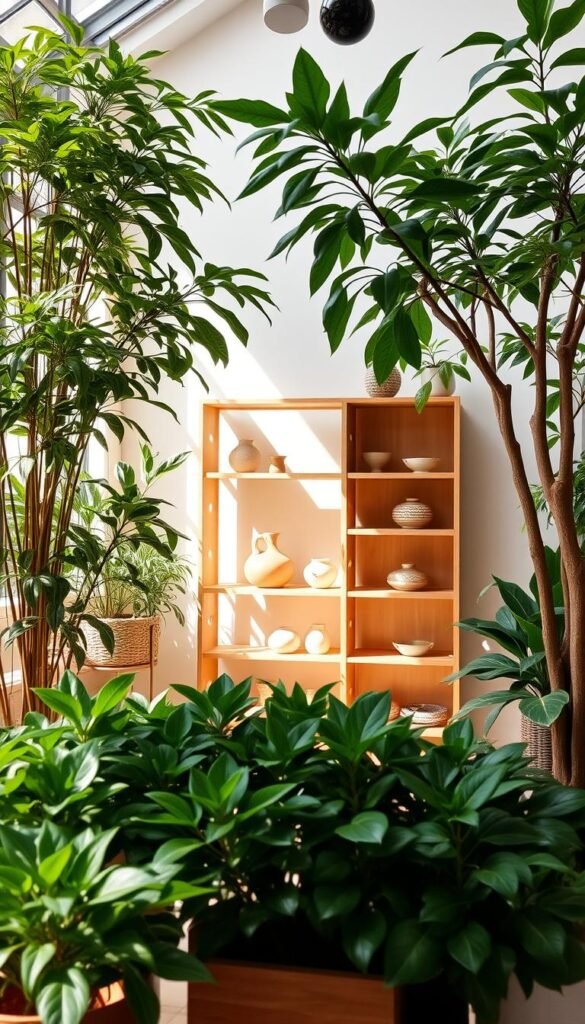
Transform your living area into a sanctuary where every plant placement feels purposeful. Good design balances greenery with negative space, creating rooms that feel both lively and restful. Feng Shui teaches us to guide energy flow through strategic arrangements—position tall plants in stagnant corners, cluster small pots near seating areas.
| Design Rule | Feng Shui Application | Visual Effect |
|---|---|---|
| Symmetry | Pair matching plants by entryways | Establishes order |
| Asymmetry | Offset large ferns with airy shelves | Adds dynamic energy |
| Rhythm | Repeat leaf shapes in decor | Creates flow |
| Scale | Match plant height to room size | Prevents overwhelm |
Color coordination matters. A burgundy begonia enhances terracotta accents, while silver pothos mirrors chrome fixtures. Your eye should glide effortlessly from foliage to furnishings without jarring contrasts.
Master visual triangles by grouping plants at three heights—floor, table, hanging. This technique naturally draws attention through your space. In open-concept homes, use greenery to define zones without walls.
Remember: balance isn’t perfection. A lopsided rubber plant beside symmetrical lamps creates intrigue. Trust your instincts—when your living area feels both energized and calm, you’ve nailed the principles.
Indoor Garden Aesthetic: Creating a Harmonious Blend of Plants and Decor
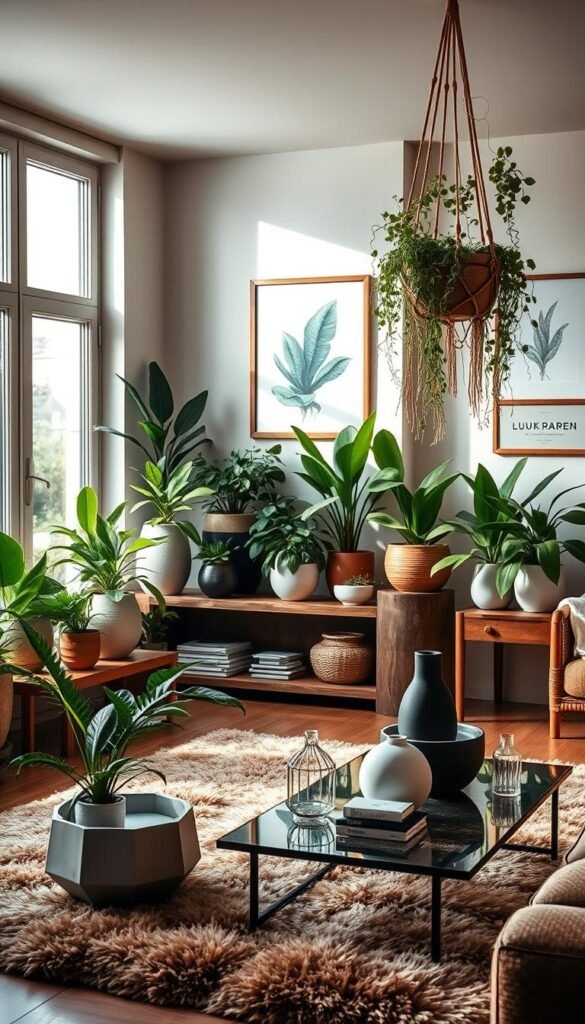
Unlock your space’s hidden potential through intentional greenery placement. Start by walking through your room with fresh eyes—notice where light pools and shadows linger. These observations become your roadmap for merging foliage with furnishings.
Step-by-Step Styling Techniques
Begin with your largest surfaces. A console table becomes a stage for trailing ivy beside framed photos. Bookshelves transform into vertical jungles when alternating books with compact succulents. Follow this simple framework:
| Surface Type | Plant Style | Decor Pairing |
|---|---|---|
| Side Tables | Low-light ferns | Textured coasters |
| Windowsills | Sun-loving herbs | Sheer curtains |
| Blank Walls | Hanging pothos | Gallery frames |
Rotate plants seasonally to match your color scheme. A burgundy rubber plant complements autumn throws, while white orchids echo winter linens. This approach keeps your living space feeling dynamic yet cohesive.
Incorporating Natural Elements Seamlessly
Blend organic textures without overwhelming your interior. Try a stone planter beside linen pillows, or a wooden stool under a leafy palm. These combinations create subtle connections between nature and nurture.
For spaces craving warmth, explore cottagecore design principles through woven baskets and clustered terracotta pots. Contrast sleek modern areas with rough-hewn plant stands that ground floating shelves.
Remember: balance thrives in repetition. Echo your fern’s frond pattern in a geometric rug, or mirror your monstera’s holes in lace curtains. These quiet harmonies make greenery feel destined for your design.
Nurturing Your Indoor Garden: Plant Care and Maintenance
Your green companions need more than occasional glances to stay vibrant. Mastering their care transforms random acts of attention into a rhythm that keeps foliage thriving. Like learning a dance, you’ll soon move effortlessly between watering schedules and light adjustments.
Watering, Light, and Fertilization Tips
Check soil weekly—poke your finger an inch deep. If it’s dry, pour room-temperature water slowly around the base. Avoid splashing leaves to prevent mold. Bright indirect light lovers like pothos will stretch toward windows, while snake plants tolerate dim corners.
Rotate pots quarterly for even growth. Feed with balanced liquid fertilizer every 4-6 weeks during spring and summer. Skip winter feedings when growth slows. Notice crispy edges? That’s your plant begging for humidity—group pots together or use pebble trays.
You’ll master reading your plant’s signals. Droopy leaves often mean thirst, while yellowing suggests overwatering. Track each species’ needs in a gardening journal. Soon, you’ll adjust routines instinctively, creating a lush sanctuary that reflects your dedication.

